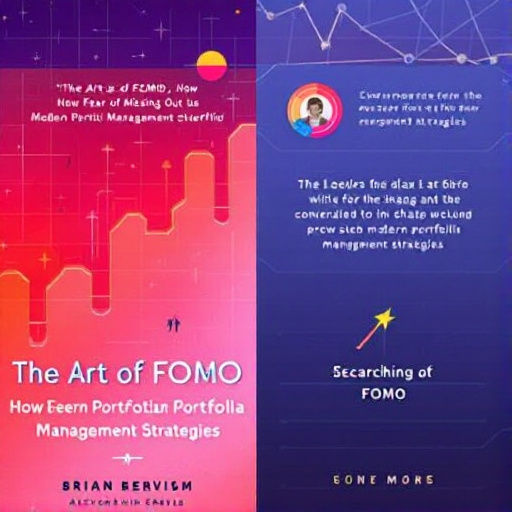Featured Articles
- “Beneath the Surface: How Behavioral Finance Secrets Can Transform Your Portfolio Management Strategy”
- "Blind Spots in Portfolio Management: Unveiling the Impact of Psychological Bias on Investment Decisions"
- Navigating the Dark Side: The Ethics of AI in Portfolio Management and Its Impact on Investment Strategies
- "Reimagining Portfolio Management: How Gamification Could Transform Investment Strategies for the Next Generation"
- The Art of FOMO: How Fear of Missing Out Shapes Modern Portfolio Management Strategies
"Blind Spots in Portfolio Management: Unveiling the Impact of Psychological Bias on Investment Decisions"
"Blind Spots in Portfolio Management: Unveiling the Impact of Psychological Bias on Investment Decisions"
Understanding the psychological biases that influence investment decisions is crucial for effective portfolio management. This article explores common blind spots that can skew decision-making, impacting financial outcomes and long-term investment strategies.
The Psychological Landscape of Investing
Imagine you’re at a carnival, and you spot a game where you’re guaranteed to win a plush toy if you hit a target with a ball. If you miss, however, you have to pay twice as much for another throw. This scene parallels investing, where psychological biases distort our judgment and lead to ill-informed decisions. According to Behavioral Finance experts, nearly 80% of investment decisions are influenced by emotional and cognitive biases rather than logical assessments (CFA Institute).
Anchoring: The Price Tag Dilemma
Anchoring is a cognitive bias that can hijack our investment judgement. Consider this: you bought shares of company X for $100 each. If the stock price falls to $60, the psychological anchor of your initial purchase price may lead you to cling to your investment, hoping it returns to that number, rather than evaluating its current value or the company's future performance. A study from the University of California, Berkeley found that investors who anchor to past prices typically achieve worse outcomes than those who analyze current market trends.
The Illusion of Control
Ever thought you could somehow control the stock market by just monitoring it closely? Welcome to the illusion of control! This bias convinces investors that they have more influence over random events than they actually do. For example, day traders often experience this illusion, believing that their expertise can outsmart market fluctuations. However, research shows that day trading is more akin to gambling than investing, with up to 80% of day traders losing money over time (Chancellor, 2020).
Case Study: The Dotcom Bubble
In the late 1990s, many investors fell victim to the illusion of control during the dotcom bubble. They were convinced that every tech startup was destined for success, leading to inflated stock prices and speculative trading (Shiller, 2000). When the bubble burst in 2000, many faced devastating losses as reality set in, demonstrating how easily optimism and overconfidence can lead to catastrophic investment failures.
Loss Aversion: The Pain of Losing
Loss aversion is the phenomenon where the pain of losing is psychologically more impactful than the pleasure of gaining. A series of experiments by Daniel Kahneman and Amos Tversky revealed that investors typically require a 2 to 3 times greater potential gain to offset the discomfort of a loss. This bias can result, for instance, in holding onto poorly performing stocks long after they should be sold, ultimately leading to untenable investment portfolios that drag down overall performance.
The Consequences of Herd Mentality
Next up: the herd mentality. It's like being at a party and seeing everyone dancing to the latest hit. You get swept along, even if you don't know the moves. This bias compels investors to make decisions based on the behavior of others rather than their own analysis. In a 2018 study by the National Bureau of Economic Research, it was found that people in groups can collectively create bubbles by blindly following trends. When investors rushed into cryptocurrency in 2017, many rode the hype wave without understanding the fundamental value, leading to significant losses when the bubble popped.
Real-life Example: The GameStop Saga
Fast forward to early 2021 when members of a Reddit community, r/WallStreetBets, banded together to buy shares in GameStop. What started as a joke snowballed into a buying frenzy that ironically sent the price soaring—real people suddenly found themselves able to counter institutional investors (The Wall Street Journal, 2021). However, as the frenzy died down, thousands of amateur investors learned the hard way that jumping on trends without fundamental understanding led to many becoming financially hurt.
The Confirmation Bias Trap
Confirmation bias is the tendency to search for, interpret, and remember information that confirms one’s preconceptions. For example, if you believe that technology stocks will outperform the market, you’re likely to read articles supporting that view and disregard opposing information. This selective attention can lead to poor decision-making; as confirmed by a study published in the Journal of Behavioral Finance, investors often miss critical information about potential risks due to confirmation bias.
Strategies to Mitigate Psychological Bias
Fortunately, recognizing these biases is the first step towards better portfolio management. Here are a few strategies to help mitigate their effects:
- Set investment goals: Clear, long-term goals can help guide decision-making.
- Seek diverse perspectives: Consult with financial advisors or friends for different viewpoints.
- Automate your investments: This can reduce emotional decision-making by creating a structured approach.
- Develop a systematic review process: Regularly review your portfolio against market changes to help shift your attention from emotional biases.
Humor: The Lighter Side of Biases
Let’s pause for a second and lighten the mood. Have you ever thought about your investment choices as you would your diet? It's like saying, “I shouldn’t eat that donut, but it’s so deliciously sugary—that wine and dine will make me feel so good temporarily!” But just like that donut, some investment choices can give immediate euphoria but lead to a stomach ache later—oh, the irony of choices!
Storytelling: The Cautionary Tale of Janet
Once upon a time, there was an investor named Janet, who thought she had it all figured out. Armed with her smartphone and a few articles read during her coffee breaks, she spent her evenings memorizing stock market dynamics—at least, she thought. One day she stumbled upon an "influencer" on social media claiming that stock in Company Y was the next big thing. Janet, overridden by excitement and fear of missing out, invested her savings without further research. Fast forward a few months: Janet learned that Company Y was embroiled in scandal after scandal, and the price plummeted. Moral of the story? Always research before you leap!
Conclusion: Navigating the Financial Maze
Psychological biases are unavoidable, but they don’t have to define your investment journey. By acknowledging these biases, actively seeking diverse viewpoints, and implementing structured investment strategies, investors can enhance their portfolio management and reduce blind spots. Remember, investing is not just about numbers; it’s about navigating the complex interplay of emotions, perceptions, and market realities. As the saying goes: “The journey of a thousand miles begins with a single step.” Take that step today and pave the way for a more informed financial future.




